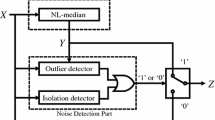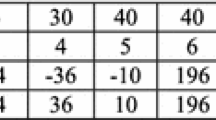Abstract
In the field of digital image processing, denoising is one of the basic problems. The challenges faced in image denoising are detecting impulse noise and designing a suitable filter. In this paper, we propose a methodology to remove the random impulse noise on the color image using a novel switching median filter. By using this novel technique, the occurrence of color artifacts has been avoided after noise removal which depends on auto-tuning threshold detection and a vector-type median filter noise remover. In the proposed technique, the random valued impulse noises with uniform distribution have been dealt with switching median filter. L2 Norm is employed to calculate the distribution distance rather than L1 Norm which is used to identify the optimal threshold value for auto-tuning filter. The switching auto-tuning detector automatically tunes the noisy pixels based on distance information of pixels distribution. The Normalized Mean Square Error (NMSE) is found to decrease for L2 Norm when compared with L1 Norm. The Peak Signal to Noise Ratio (PSNR) value and True Positive Rate (TPR) value improved with L2 Norm signifying effective noise removal. The efficiency of the present method is verified by conducting experiments on digital images.







Similar content being viewed by others
Data availability
Data used in the current is available on reasonable request to the corresponding author.
References
Pandey BK, Pandey D, Wariya S, Aggarwal G, Rastogi R (2021) Deep learning and particle swarm optimisation-based techniques for visually impaired humans’ text recognition and identification. Augment Hum Res 6(1):1–14
Chen T, Ma K, Chen LH (1999) Tri-state median filter for image denoising. IEEE Trans Image Process 8(12):1834–1838
Chen T, Wu HR (2001) Space variant median filters for the restoration of impulse noise corrupted images. IEEE Trans Circuits Syst II Analog Digital Signal Process 48(8):784–789
Chen CH, Chen CY (2009) Intelligent adaptive sub band based multi-state median filter in lowly corrupted images. Int J Innov Comput Inf Control 5(9):2917–2926
Pandey D, Pandey BK, Wariya S (2019) Study of various types noise and text extraction algorithms for degraded complex image. J Emerg Technol Innov Res 6(6):234–247
Kubota R, Onaga K, Suetake N (2014) Switching median filter with signal dependent thresholds designed by using genetic algorithm. In: International conference on computer vision theory and applications (VISAPP), Lisbon, pp 222–227
Ng P, Ma K (2006) A switching median filter with boundary discriminative noise detection for extremely corrupted images. IEEE Trans Image Process 15(6):1506–1516
Zhang X, Yin Z, Xiong Y (2008) Adaptive switching mean filter for impulse noise removal. IEEE Congr Image Signal Process 3:275–278
Pandey D, Pandey BK, Wariya S (2019) Study of various techniques used for video retrieval. J Emerg Technol Innov Res 6(6):850–853
Celebi ME, Aslandogan YA (2008) Robust switching vector median filer for impulse noise removal. J Electron Imaging 17(4):043006-1–043006-9
Ibrahim H, Abdal Ameer AK (2019) Improvement of quantized adaptive switching median filter for impulse noise reduction in gray-scale digital images. Turk J Electr Eng Comp Sci 27:580–595
Toh KKV, Mat Isa NA (2010) Noise adaptive fuzzy switching median filter for salt-and-pepper noise reduction. IEEE Signal Process Lett 17(3):281–284
Xiao L, Li C, Wu Z, Wang T (2016) An enhancement method for x-ray image via fuzzy noise removal and homomorphic filtering. Neurocomputing 195:56–64
Hussain A, Habib M (2017) A new cluster based adaptive fuzzy switching median filter for impulse noise removal. Multimedia Tools Appl 76(21):22001–22018
Li Y, Sun J, Luo H (2014) A neuro-fuzzy network based impulse noise filtering for gray scale images. Neurocomputing 127:190–199
Pandey BK, Mane D, Nassa VKK, Pandey D, Dutta S, Ventayen RJM, Rastogi R (2021). Secure text extraction from complex degraded images by applying steganography and deep learning. In: Multidisciplinary approach to modern digital steganography. IGI Global, pp. 146–163
Jena B, Patel P, Sinha G (2018) An efficient random valued impulse noise suppression technique using artificial neural network and non-local mean filter. Int J Rough Sets Data Anal 5:148–163
Roy A, Singha J, Devi SS, Laskar RH (2016) Impulse noise removal using SVM classification based fuzzy filter from grayscale images. Signal Process 128:262–273
Pandey D, Pandey BK, Wairya S (2021) Hybrid deep neural network with adaptive galactic swarm optimization for text extraction from scene images. Soft Comput 25(2):1563–1580
Roy A, Singha J, Manam L, Laskar RH (2017) Combination of adaptive vector median filter and weighted mean filter for removal of high-density impulse noise from colour images. IET Image Process 11(6):352–361
Madhumathy P, Pandey D (2022) Deep learning based photo acoustic imaging for non-invasive imaging. Multimedia Tools Appl 81(5):7501–7518
Yan M (2013) Restoration of images corrupted by impulse noise and mixed gaussian impulse noise using bling in painting. SIAM J Imaging Sci 6:1227–1245
Pimpale N (2016) A Khambra, Optimized Systolic Array Design for Median Filter in Image Filtration. Int J Electr, Electron Comput Eng 5(1):46–53
Pandey D, Wairya S, Sharma M, Gupta AK, Kakkar R, Pandey BK (2022) An approach for object tracking, categorization, and autopilot guidance for passive homing missiles. Aerospace Syst. https://doi.org/10.1007/s42401-022-00150-0
Kubota R, Suetake N (2011) Random-valued impulse noise removal based on component-wise noise detector with auto-tuning function and vector median interpolation. J Franklin Inst 348(9):2523–2538
Wang Z, Zhang D (1999) Progressive switching median filter for the removal of impulse noise from highly corrupted images. IEEE Trans Circuits Syst II Analog Digital Signal Process 46(1):78–80
Raghavan R, Verma DC, Pandey D et al (2022) Optimized building extraction from high-resolution satellite imagery using deep learning. Multimed Tools Appl. https://doi.org/10.1007/s11042-022-13493-9
Sharma M, Sharma B, Gupta AK et al (2022) Recent developments of image processing to improve explosive detection methodologies and spectroscopic imaging techniques for explosive and drug detection. Multimed Tools Appl. https://doi.org/10.1007/s11042-022-13578-5
Pandey BK et al (2023) Effective and secure transmission of health information using advanced morphological component analysis and image hiding. In: Gupta M, Ghatak S, Gupta A, Mukherjee AL (eds) Artificial intelligence on medical data. Lecture Notes in Computational Vision and Biomechanics, vol 37. Springer, Singapore. https://doi.org/10.1007/978-981-19-0151-5_19
Sharma M, Sharma B, Gupta AK, Khosla D, Goyal S, Pandey D (2021) A study and novel AI/ML-based framework to detect COVID-19 virus using smartphone embedded sensors. In: Agrawal R, Mittal M, Goyal LM (eds) Sustainability measures for COVID-19 pandemic. Springer, Singapore. https://doi.org/10.1007/978-981-16-3227-3_4
Funding
No funds.
Author information
Authors and Affiliations
Contributions
All authors contributed to the manuscript. Finally, all authors read and approved the manuscript.
Corresponding author
Ethics declarations
Conflict of interest
The authors declare no conflict of interest.
Rights and permissions
Springer Nature or its licensor holds exclusive rights to this article under a publishing agreement with the author(s) or other rightsholder(s); author self-archiving of the accepted manuscript version of this article is solely governed by the terms of such publishing agreement and applicable law.
About this article
Cite this article
Bruntha, P.M., Dhanasekar, S., Hepsiba, D. et al. Application of switching median filter with L2 norm-based auto-tuning function for removing random valued impulse noise. AS 6, 53–59 (2023). https://doi.org/10.1007/s42401-022-00160-y
Received:
Revised:
Accepted:
Published:
Issue Date:
DOI: https://doi.org/10.1007/s42401-022-00160-y




